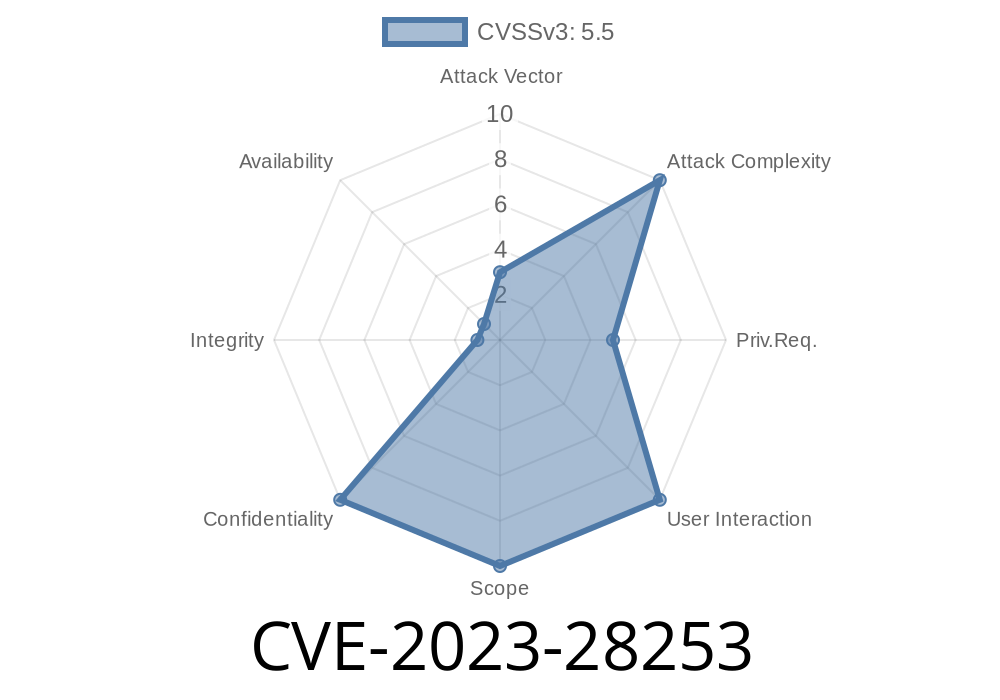In April 2023, Microsoft patched a serious vulnerability in its Windows operating system, tracked as CVE-2023-28253. This was an information disclosure issue in the Windows Kernel that could potentially allow attackers to leak sensitive information from the system memory. If you’re curious about what this bug is, how it works, and how it’s exploited, keep reading. We’ll break it down in simple terms, show you relevant code snippets, and provide links for deeper reading.
What is CVE-2023-28253?
CVE-2023-28253 is a security bug found in the Windows Kernel—the core component of Windows that manages system resources and allows hardware and software to communicate. According to Microsoft’s official advisory, this vulnerability lets a local attacker read kernel memory that belongs to privileged Windows processes.
Severity: Important
CVSS Score: 5.5 (Medium)
Here’s what Microsoft says
> "An information disclosure vulnerability exists when the Windows Kernel allows disclosure of uninitialized memory locations to attackers."
Why Does It Matter?
Any leak from the kernel can make other attacks much easier—especially privilege escalation, where hackers try to run code with higher permissions. Attackers can also use the leaked data to bypass security features like ASLR (Address Space Layout Randomization).
How Does it Work? (Simplified)
The bug exists because the Windows Kernel doesn’t always clean (zero out) memory before copying it to user space. This means data from one process might remain in memory and be visible to another, less trusted, process.
Imagine taking notes on a notepad, erasing some, and then giving it to a stranger—who can use pencil rubbings to read what you erased. That’s similar to what’s happening here.
Vulnerable API: NtQueryIntervalProfile
Security researchers found the vulnerable function was NtQueryIntervalProfile—a system call used to retrieve interval timers for profiling. This function indirectly sends a structure from kernel memory back to user space, but doesn’t always zero out all its fields.
- Analysis by Trend Micro’s Zero Day Initiative
Example Vulnerable Code Snippet (C Style)
Note: This is a simplified version for educational purposes.
The key mistake: not initializing all structure fields before returning to user space.
typedef struct _PROFILE_DATA {
ULONG Interval;
ULONG Count;
// ...imagine other fields, possibly uninitialized
} PROFILE_DATA;
NTSTATUS NtQueryIntervalProfile(
IN ULONG ProfileSource,
OUT PULONG Interval
) {
PROFILE_DATA profileData;
// Only part of the structure is initialized
profileData.Interval = GetProfileInterval(ProfileSource);
// Oops - Count and other fields are left uninitialized
// Kernel copies the structure, including uninitialized fields, to user buffer
memcpy(userBuffer, &profileData, sizeof(PROFILE_DATA));
return STATUS_SUCCESS;
}
Issue:
Fields like Count may contain leftover data from privileged kernel memory. This gets copied back and *leaked* to the attacker’s process!
How Can an Attacker Exploit It?
1. Unprivileged User Space Code: Attacker invokes the vulnerable NtQueryIntervalProfile syscall from a non-admin account.
2. Receives Leaked Data: The attacker’s code receives buffer data with *some* bytes filled with random leftover bytes from kernel memory—possibly pointers, secrets, or credentials.
3. Analyzes for Sensitive Data: They parse the bytes, looking for passwords, tokens, or memory layout information to aid further exploitation.
Example Exploit (Proof-of-Concept, in Python using ctypes)
import ctypes
from ctypes import wintypes
# NtQueryIntervalProfile prototype
ntdll = ctypes.WinDLL('ntdll')
NtQueryIntervalProfile = ntdll.NtQueryIntervalProfile
NtQueryIntervalProfile.argtypes = [wintypes.ULONG, ctypes.POINTER(wintypes.ULONG)]
NtQueryIntervalProfile.restype = wintypes.NTSTATUS
interval = wintypes.ULONG()
ProfileTotalIssues = 2 # Arbitrary constant, may change
# Call the syscall
status = NtQueryIntervalProfile(ProfileTotalIssues, ctypes.byref(interval))
print(f"NTSTATUS: {status}")
print(f"Interval Data: {interval.value}")
# In real PoC, more bytes can be leaked if you use a larger buffer struct
*Note: This code, as presented, is safe; but if the real vulnerable structure size is bigger, you might read hidden data.*
Mitigation
* Microsoft fixed this bug by zeroing out all memory before returning data to user space.
* To stay safe, update your Windows systems with the latest security patches from April 2023 or later. (Patch Tuesday – April 2023)
More References & Further Reading
- Microsoft Security Advisory CVE-2023-28253
- ZDI Advisory – Windows Kernel Information Disclosure Vulnerability
- Talos Security Analysis
- Windows Internals – How Syscalls Work
- CWE-908: Use of Uninitialized Resource
Summary
CVE-2023-28253 is an important example of why memory management in kernel code needs to be perfect. It shows how easy it is for secrets to leak when code fails to zero memory before sharing it with less trusted apps. Always keep your systems updated, and if you’re a developer writing low-level code—make sure to initialize all the fields!
Stay Safe! Update and Patch Regularly.
*Please share this post if you found it useful, and follow responsible disclosure principles when working with real vulnerabilities.*
Timeline
Published on: 04/11/2023 21:15:00 UTC
Last modified on: 04/13/2023 01:10:00 UTC
